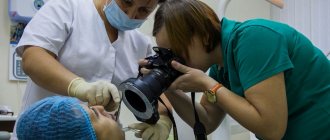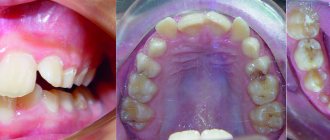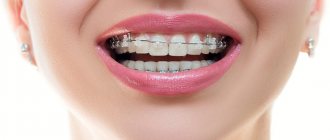Oral sanitation is a set of procedures aimed at cleansing the oral cavity of various bacteria. This is a mandatory step before implantation, since the main requirement for a complex operation is the sterility of the entire oral cavity. In addition, during the rehabilitation, teeth whitening will be performed, which is also very important for creating a new and beautiful smile.
Sanitation of the oral cavity: preparation for implantation
- treatment of teeth and gums
- removal of tartar and plaque
- treatment of teeth with a fluoride-containing preparation
- teeth whitening
Treatment of teeth and gums
Treatment of teeth and gums is a mandatory procedure at the stage of preparation for implantation. It is important to rid the oral cavity of bacteria that accumulate on the teeth and cause various diseases. After implantation, you will receive new and completely healthy teeth.
Removing tartar and plaque
Plaque is bacteria that accumulates on our teeth. Tartar is hardened plaque, it is much more difficult to remove from the surface of the teeth, and it causes significant damage to the enamel, gradually destroying the tooth and injuring the gums. Plaque removal is essential to restoring healthy teeth and gums.
Tartar: symptoms of appearance
- bad breath
- the formation of gum pockets (at the base of the teeth, the gums peel off from their surface, and plaque appears underneath them)
- bleeding gums
Tartar removal:
To remove tartar, the medical center uses modern ultrasonic equipment , which allows the hard plaque to be broken down into small particles, after which it is easily removed from the teeth. An ultrasonic installation allows you to remove even complex tartar, which is located under the gums, without pain and discomfort.
Treatment of teeth with a fluoride-containing preparation
After removing tartar and plaque, it is necessary to strengthen the tooth enamel - for this, fluoride-containing preparations are used, which are applied to the surface of the teeth for a certain time. They penetrate deep into the tooth, making it stronger and healthier.
Teeth whitening
The final stage in the process of sanitation of the oral cavity will seem to many patients the most pleasant - teeth whitening. In order to change the color of teeth by several shades, we use the Air Flow device - it also allows you to remove minor plaque, but its most effective use is justified in combination - after cleaning the teeth with ultrasound.
What is Air Flow?
Air Flow is a technology that allows you to change the color of your teeth by several shades and give them a more natural and natural look. Teeth cleaning is painless and safe: a stream of water is directed onto the teeth, to which an abrasive substance has been added. Strong pressure allows you to remove dirt, and a special substance significantly whitens teeth, mainly by removing various dirt from the surface.
It is also recommended to whiten your teeth to a natural shade so that after implantation, you can choose dental crowns that will serve as a natural complement to your snow-white living teeth.
Other jobs
How much treatment is possible in 1 visit?
The maximum duration of treatment under sedation is 14 consecutive hours
- Carry out comprehensive oral hygiene
- Cure caries, pulpitis or periodontitis
- Remove dental cysts
- Remove teeth, including wisdom teeth
- Fix the bracket system or aligners
- Install up to 16 implants
- Perform bone grafting on the lower jaw, sinus lift or revision of the maxillary sinus on the upper
- Install a comfortable and beautiful fixed prosthesis supported on your own teeth or on implants
How to treat all teeth in 1 day “in a dream”
Why do teeth need to be treated before correction starts?
- Moving teeth with braces activates existing dental problems, since the locks on the teeth make it much more difficult to perform hygiene procedures.
- When the disease enters an acute phase, it is often necessary to remove some braces and an orthodontic arch to treat it. After all, it can be quite difficult for a patient to open his mouth in such a way as to provide access to a hard-to-reach problem area, and it is very difficult and inconvenient for a doctor to treat teeth with braces.
- In addition, braces can make it difficult to make diagnoses, such as taking x-rays of the tooth.
Any infection dormant in the oral cavity will sooner or later become active. So why delay treatment if a small problem will eventually develop into a big one, requiring significant financial costs?
Who chooses to have all their teeth treated “in their sleep”
For everyone who values their time and is accustomed to a certain quality of life, i.e. for everyone, although 10 years ago this format was of interest only to “big screen” stars and patients from other cities
- Super-busy Muscovites If you don’t have time to go to the dentist, like going to work, in traffic jams, in the evening, 2 times a week for six months to a year to get your teeth in order, and the problem is put off and put off for years
- Patients not from Moscow Every month we accept at least 10 patients from Russia and Europe. The operations are planned remotely; you only need to come for diagnostics and the operation itself. Very comfortably!
- Public people of all professions Privacy, quick results and the absence of visible signs of treatment on the face are why this technique has long been loved by show business stars, politicians, businessmen, and more recently bloggers
- Connoisseurs of comfort You can treat your teeth in the format of a SPA procedure. Fall asleep and wake up when it's all over. Not seeing or remembering the process. Do not hear medical odors and unpleasant sounds. Get the result and go home!
- Parents of responsible children If your parents are also the type who wouldn’t let a dentist near them at the drop of a hat, but walk around without teeth, then the only treatment format they can agree to is “all in 1 visit.” Checked!
- All those who do not like dentists Uncontrollable feelings of fear, panic reactions, negative experiences with a dentist in the past - all this is a direct indication for treatment in medicinal sleep
What is rehabilitation?
Sanitation includes procedures prescribed to the patient during an examination by a dentist and designed to eliminate or stop the further development of a number of dental diseases and improve the condition of the teeth and oral cavity as a whole.
Rehabilitation includes:
- Treatment of caries.
- Filling.
- Tooth extraction.
- Tartar removal.
- Treatment of marginal periodontal diseases (periodontitis, gingivitis, periodontal disease).
Sanitation of the oral cavity is indicated for both adults and children. Sanitation is carried out by a dentist-therapist. In the absence of special circumstances (poor health, unfavorable living or working conditions, etc.), it is recommended to carry out sanitation at least twice a year.
Stages of treatment
Below we have provided a sequence of standard activities for successful planning and treatment. Of course, some meetings can be combined into one visit, and in some cases vice versa. Please do not treat the listed stages literally, as imperative norms.
Initial consultation
The purpose of the initial consultation is to determine the overall treatment strategy.
- Identify patient complaints and wishes
- Determine the color and condition of tooth enamel
- Visually assess the condition of soft tissues (the gum is not visible on the CT image)
- Diagnose the functionality of the joint
- Carry out a photo protocol for further work on the smile design, taking into account facial features
The standard duration of the initial consultation at the Center is 60 minutes, which can be increased at the patient’s request. It is enough to inform the operator about this by phone when making an appointment.
In accordance with the Center’s Unified Quality Standards, initial consultations are carried out only if there is a high-quality 3D X-ray computed tomography image. If you already have a photo on CD or DVD that is no older than 8 weeks, take it with you. If you don’t have a photo, you can take one with us before your consultation.
If you do not live in Moscow, but are considering our Center as your future medical institution, please send a CT scan to the clinic’s email. Our doctors do not make diagnoses or provide consultations remotely, but they will be able to draw up several preliminary treatment plans with approximate time frames.
Initial consultations at the Center are paid. We do not encourage “luring” patients with free consultations for the purpose of selling services. Our doctors are engaged in medicine, not business, so their time is paid. A patient who contacts us for the first time can be sure that he will receive an objective opinion.
Repeated consultation
The purpose of the repeat consultation is to determine treatment tactics. At our Center, several doctors always take part in planning. This takes some time. We always ask patients to treat this phenomenon with understanding. Below we will try to justify why time and medical collegiality are needed.
- Orthopedist As a rule, during complex treatment, the initial consultation is always carried out by an orthopedic dentist and, by default, becomes the responsible attending physician for the patient . The orthopedist determines which specialized specialists need to be involved to plan treatment.
- The endodontist determines the consistency of the patient's remaining teeth. This is perhaps the most important part of planning, because... Excessive hopes for the canals of preserved teeth can lead to breakdowns, complications and the need to redo something within a year. Often, in order to accurately assess the durability of a tooth, especially one previously treated in third-party medical institutions long ago, it is necessary to conduct additional diagnostics using a microscope.
- Dental and maxillofacial surgeon Evaluates the condition of bone tissue, gums and maxillary sinuses. Determines the degree of difficulty of tooth extraction, if necessary, positions implants, plans work with soft tissues.
- Orthodontist Comes to the rescue with malocclusion, problems with the temporomandibular joint and in cases where there are indications for straightening teeth, for example, in order to eliminate crowding.
- Periodontist In many cases, we recommend treatment only after complex periodontal therapy because inflammatory processes in the soft tissues can, firstly, lead to immediate postoperative complications, and secondly, affect the durability of treatment results. We strive to ensure that our treatment lasts the patient's entire life.
Coordination of treatment tactics with 3-4 different specialists has been a completely standard practice in our Center for many, many years. Doctors may not recognize you by sight, but they remember your CT scan very well.
Of course, if you just need to cure caries on 7-8 teeth under sedation, one consultation with a dentist-therapist and an acquaintance with our anesthesiologist-resuscitator is enough, and already at the second meeting you will leave the clinic with complete sanitation of the oral cavity.
Fundamental diagnostics
In order for new teeth to last a lifetime, all the individual characteristics of the patient must be taken into account. For this purpose, various targeted in-depth diagnostic examinations of the oral cavity are carried out.
- Radiography Based on a computed tomography image, the condition of the bone tissue and the condition of the maxillary sinuses are determined, the dislocation of the implants, their size, position, and the possibility of performing implantation simultaneously with removal or with bone grafting are planned.
- Taking silicone impressions and making diagnostic models Allows you to obtain a copy of the patient’s teeth, the minimum necessary measure for orthopedic and orthodontic treatment.
- Digital 3D scanning of the oral cavity A modern and more accurate alternative to silicone impressions and plaster models. Allows you to instantly obtain a digital model on a computer for transmission to a dental technician, planning orthodontic treatment and making designs for future teeth.
- High-precision examination using a facebow and articulator Establishes the true trajectory of the lower jaw. Due to tooth wear, prolonged absence, hypertonicity of the jaw muscles and many other reasons, the lower jaw “loses” anatomical landmarks. Prosthetics “by eye” in such cases leads not only to the fact that the expensive prosthesis will not last long, but also to the development in the near future of arthrosis, arthritis, headaches and difficulty opening or closing the mouth.
- Neuromuscular TENS diagnostics It is used in cases where the tone of the jaw muscles is so increased that it is impossible to establish a reliable trajectory of jaw movement. The first signs of hypertonicity are bruxism, headaches, sleep disturbances, and discomfort in the cervical spine. TENS therapy using microcurrent impulses relaxes muscles, relieves spasms and allows for diagnostics.
- Inspection of canals under a microscope Allows you to determine with 99% accuracy whether it will be possible to save it with periodontitis or a cyst or not, as well as how many years a previously treated tooth will last in a third-party medical institution.
- Anesthesiological history In some cases, before the operation, a personal meeting with the Center’s staff anesthesiologist is required to clarify the anamnesis.
Planning the operation
A CT scan, photographs, and the results of additional diagnostic studies are collected together and a detailed treatment plan or several plans are drawn up.
If several visits are expected, then each is planned separately, with the timing and amount of the patient’s costs for each stage. As part of the operating day, the sequence of participation of each doctor is approved, and the required amount of time is recorded in the schedule.
The orthopedic dentist, using a special program, models the design of the future smile, produces a digital wax-up and coordinates the color and shape of the teeth with the patient before treatment begins. If necessary, a mock-up is made, a model of future teeth for fitting in the oral cavity, with which you can take a photo, show it to your spouse, leave the clinic and make a decision in a relaxed atmosphere.
The terms, cost of treatment, treatment procedure and warranty obligations for each of the treatment options, if there are several, are approved.
Operation
Complex treatment is carried out under sedation, a state of artificial medicinal sleep.
Sedation is not anesthesia; narcotics are not used, only ultra-short-acting hypnotics, such as propofol and diprivan. “Coming out” of sedation takes from 10 to 30 minutes and you can go home. Unlike anesthesia, breathing is not suppressed, there is no nausea, dizziness, and there is no need to stay in the hospital after the operation.
- We recommend planning the start of treatment in the morning.
- Restrictions: do not drink water 2 hours before operations under sedation, do not eat food 4 hours before.
- The clinic has a recovery room where you can rest when the doctors are finished.
- There is no need to run to pharmacies after treatment. All necessary medications and care products are provided within the Center.
Branded accelerated rehabilitation
The Center uses a unique proprietary rehabilitation complex to eliminate signs of surgical treatment. A course of 30-40 minutes completely eliminates swelling, hematomas and significantly reduces postoperative pain. The course uses microcurrent and injection therapy, which gives an immediate effect.
How to get a certificate of oral sanitation?
A certificate is issued by a dentist, which contains the phrase: the oral cavity has been sanitized. When does it become necessary to obtain a dentist’s opinion on oral sanitation?
- When registering during pregnancy.
- Before childbirth.
- When working in an enterprise with hazardous working conditions.
- When applying for a new job.
- On the eve of surgery, when sanitation of the oral cavity is required before surgery.
- When preparing documents for school or kindergarten.
- When applying for a medical record.
You can buy a certificate without queues and still receive quality treatment in a good specialized clinic.
PiezoSurgery® – ultrasound surgery
We work with bone tissue and remove teeth using a minimally invasive piezosurgical protocol
- Minimal trauma - the bone is not damaged, it is delicately softened
- The device affects only hard tissues, damage to the sinus membrane is excluded during sinus lifting
Cost of treatment
A special feature of the estimate for dental treatment for 1 day is the absence of stages of payment and the inclusion of the cost of several hours of sedation. Otherwise, the assessment procedure is no different from the traditional procedure. At the initial consultation, the doctor collects anamnesis, assesses the general condition of the oral cavity and joints, analyzes a computed tomography scan and makes a diagnosis. At this stage, the approximate order of expenses can always be determined. For a more accurate assessment, the opinion of related specialists will be required.
In 90% of cases, patients seek help under the “one visit” program with complex problems, so the cost is summed up from therapeutic, surgical, and orthopedic work.
Sign up for a paid consultation with the leading specialists of the Center or with the Chief Physician Dmitry Valerievich Levin and get an unbiased opinion about the treatment specifically in your case.
What does the price depend on?
The cost of sanitation depends on the condition of the patient’s teeth, the qualifications of the doctor, and the place of residence. The choice of clinic will also affect the price . It costs less to have your teeth treated in a city dental clinic than in a private dental office or a branch of a network clinic. A citizen of the Russian Federation can apply for free dental care under the compulsory medical insurance policy.
The cost of dental services varies greatly even within the same city . This is due to the medications, instruments, and equipment used. For example, under the compulsory medical insurance policy, only Russian-made medicines and instruments are offered. Imported materials are not included in compulsory insurance; the patient must pay for them separately.











